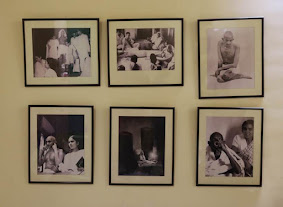Finding Hyderi Manzil in today’s Kolkata is not easy. Few know of its name and even fewer know of its significance. To search for Hyderi Manzil, a relatively small one-storey building painted white in the Beliaghata neighbourhood of the city, one would have to invoke the name of the most well-known of its many residents—Mohandas Karamchand Gandhi. Hyderi Manzil, christened ‘Gandhi Bhawan’ by West Bengal Chief Minister Mamata Banerjee in 2018, is the last known address where Gandhi lived during his last visit to the city before his death in 1948. Tucked away in a narrow lane off the main road in Beliaghata, the building has now been made into a museum.
 Calcutta broke into bloody riots within days of Independence. During this turbulent phase, Gandhi decided to come to Calcutta and stay at Hyderi Manzil, a rundown and virtually abandoned structure then at the heart of what was Mianbagan in Beliaghata.
Calcutta broke into bloody riots within days of Independence. During this turbulent phase, Gandhi decided to come to Calcutta and stay at Hyderi Manzil, a rundown and virtually abandoned structure then at the heart of what was Mianbagan in Beliaghata. It was in one of Hyderi Manzil’s eight rooms, cleaned up to make it relatively habitable, that Mohandas Karamchand Gandhi spent the tumultuous period between August 13 and September 7, 1947. It was in this mansion that Gandhi personally brokered peace between Hindus and Muslims, fasting for 73 hours until key leaders of the warring groups had laid their arms down at his feet and sworn off communal violence on September 4.
 The building bears witness to a vital chapter of Indian history.Calcutta broke into bloody riots within days of Independence. During this turbulent phase, Gandhi decided to come to Calcutta and stay at Hyderi Manzil, a rundown and virtually abandoned structure then at the heart of what was Mianbagan in Beliaghata. It was in one of Hyderi Manzil’s eight rooms, cleaned up to make it relatively habitable, that Mohandas Karamchand Gandhi spent the tumultuous period between August 13 and September 7, 1947. It was in this mansion that Gandhi personally brokered peace between Hindus and Muslims, fasting for 73 hours until key leaders of the warring groups had laid their arms down at his feet and sworn off communal violence on September 4. The building bears witness to a vital chapter of Indian history.
The building bears witness to a vital chapter of Indian history.Calcutta broke into bloody riots within days of Independence. During this turbulent phase, Gandhi decided to come to Calcutta and stay at Hyderi Manzil, a rundown and virtually abandoned structure then at the heart of what was Mianbagan in Beliaghata. It was in one of Hyderi Manzil’s eight rooms, cleaned up to make it relatively habitable, that Mohandas Karamchand Gandhi spent the tumultuous period between August 13 and September 7, 1947. It was in this mansion that Gandhi personally brokered peace between Hindus and Muslims, fasting for 73 hours until key leaders of the warring groups had laid their arms down at his feet and sworn off communal violence on September 4. The building bears witness to a vital chapter of Indian history.The museum depicts the various aspects of the life of the Father of the Nation. It bears the most prominent footprints of Gandhiji in Kolkata. Spread over 3, 500 sq ft, the permanent exhibition — Mohandas to Mahatma — has 41 story-line display panels where the life of Gandhiji is depicted in three sections. Letters, photographs, display panels and even graphics depicting different facets of Gandhiji’s life are on display.

